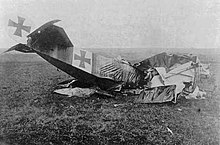Heinrich Gontermann
Heinrich Gontermann (born February 25, 1896 in Siegen , † October 30, 1917 in Marle , Département Aisne , France ) was a German fighter pilot in the First World War .
Life
Gontermann was born as the son of a cavalry officer , the factory owner Heinrich Gontermann (died December 12, 1929). At the beginning of the war he joined a Prussian Uhlan regiment . He was wounded in August 1914. In 1915 he asked to be transferred to the air force , which was approved a short time later. For almost a year he flew reconnaissance missions in a C.II biplane.
When the German Air Force was set up and there was an increased need for fighter pilots towards the end of 1916, Gontermann joined Fighter Squadron 5. On November 14th of the same year he shot down the first enemy aircraft and by April 6, 1917 he achieved a total of seven aerial victories . Two days later, he shot down the first enemy balloon . Because of his success, he was appointed chief of Jagdstaffel 15.
Gontermann developed into an expert in attacks on the observation balloons operating close to the front. These were particularly important for both sides as they coordinated the artillery fire. If several tethered balloons could be switched off in one area, the artillery could no longer be supplied with enough information about enemy movements. Because of their importance, these balloons were heavily secured by machine guns and anti-aircraft guns . Pilots like Gontermann therefore had to master the tactics of the fall attack perfectly. Diving was particularly dangerous at the time of the First World War, as the relatively light (wooden) construction of the aircraft was already endangered by the high speed with acting forces. However, the dive was the best option for balloon attacks, the target acquisition of the air defense was much more difficult compared to other attack methods.
Heinrich Gontermann was next to Friedrich von Röth the best German "balloon hunter". On August 19, 1917, he shot down four tethered balloons. Because of his extraordinary achievements, he received the order Pour le Mérite on May 11th of the same year . In October 1917, Gontermann's unit was equipped with the Fokker Dr.I three- decker . This machine was relatively slow, but very agile. When he undertook a test flight over his airfield near Marle on October 30, 1917 , the triplane lost part of its upper wing and crashed. Badly injured, he was rescued and died a little later in hospital. In total, Gontermann shot down 39 enemy aircraft.
Others
In Stuttgart-Sillenbuch there is a Heinrich-Gontermann-Weg in memory of the fighter pilot. The Werner-Voss -Weg and Paul-Bäumer -Weg are in the immediate vicinity . In Berlin-Tempelhof there is the Gontermannstraße as a reminder, here too the Werner-Voss-Damm and the Bäumerplan are in the immediate vicinity, other streets in the Neu-Tempelhof settlement are also named after pilots, such as the Manfred-von-Richthofen -straße , the Boelcke street or the Udet line.
Awards
- Prussian military pilot badge
- Iron Cross 2nd and 1st class
- Pour le Mérite
literature
- Jürgen Brinkmann: The knights of the order Pour le merite 1914 - 1918. Th. Schäfer Druckerei GmbH, Hannover et al. 1982.
- Arch Whitehouse: Aviator Aces 1914-1918 . Motorbuch-Verlag, Stuttgart 1970, pp. 398-401.
- Walter Zuerl: Pour le mérite-Flieger. Luftfahrtverlag Axel Zuerl, Steinebach Wörthsee 1987, ISBN 3-934596-15-0 .
- Leonhard Müller: Lieutenant Heinrich Gontermann . Barmen-U. 1919. (Digitized: [1] )
See also
Web links
| personal data | |
|---|---|
| SURNAME | Gontermann, Heinrich |
| BRIEF DESCRIPTION | German fighter pilot in the First World War |
| DATE OF BIRTH | February 25, 1896 |
| PLACE OF BIRTH | Wins |
| DATE OF DEATH | October 30, 1917 |
| Place of death | Marle |

